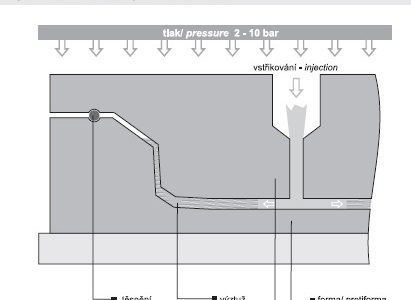Casting technologies are used for production of non-reinforced composites. The principle of the process is casting of resin usually in mixture with fillers, optionally with pigments, additives and curing components into the moulds under the conditions depending on the final product properties and application field.
Cultured marble
Cultured (synthetic) marble is produced by mixing of low viscosity resins with fillers the choice of which is very wide starting from calcium carbonate (chalk) over various inert fillers (crushed stone, mica, crushed mirrors etc.), pigments, additives and initiating compounds and subsequent casting into the moulds which are provided by gelcoat. Gelcoat is mostly transparent based on high quality ISO/NPG resins which are resistant to hot water, detergents and temperature changes.
A filler content of 75-80% is usual in cultured marble. To reach that relatively high filler content (desirable both from the cost point of view and aesthetic one) and ensure the full impregnation of all filler particles without air pockets and in the same time to preserve good flow properties it is recommendable to use the mixture of fillers of various particle size as follows:
- 0,0 – 0,1 mm 16%
- 0,1 – 0,25 mm 9%
- 0,25 – 1,0 mm 25%
- 1,0 – 4,0 mm 50%
Mixing can be made in dependence on the production volume in small mixers up to large autmated mixing and casting machines.
To reach the deep onyx effect it is necessary to use fine ground aluminium trihydrate and transparent pigments.
Moulds made from reinforced plastics, epoxy compounds, steel, aluminium, polymer concrete or silicone elastomer provided with suitable release agent can be used with regard to part dimension and series size. The material of mould must withstand the exotherm and post cure temperature.
Polymer concrete
The technology is basically similar to that used by cultured marble manufacturing. Because the products are mostly used for industrial applications there are not used neither gelcoat nor pigments.
On the other hand there is wider choice of fillers, namely cheap fillers of a coarser particle size and a higher filler load are normally used – sand, crushed stone, calcium carbonate, limestone, talc and mica. Moulds are mostly heated to speed the curing cycle and vibration is used to remove entrapped air bubbles.
Solid surface
There is very hard and resistant version of cultured marble imitating the natural stone or creating the special effects. Starting material is a mixture of special resins, especially acrylic and polyester characterized by high thermal and chemical resistance which are able to be cured to high hardness in combination with fillers. High quality and high purity aluminium trihydrate and/or chips of cured pigmented resin are used as fillers in some cases mixed with pigments.
Solid surface technology differs from cultured marble process in two main points:
- a) gelcoat is not used as a surface layer
- b) mixing of resin, fillers, pigments and curing agents is made under the vacuum
As a result there is gained homogenous non-porous and very hard material which is grinded and polished after curing. It is possible to cut it or machine it, individual parts can be bond together without glue line and thanks to gelcoat absence it is possible to repair eventual surface defects by sanding and polishing.
Suitable materials
- Cultured marble:high quality ISO/NPG gelcoats, common polyester resins ortho- or isophtalic type, fillers and pigments
- Onyx: as by cultured marble, alumina trihydrate as a filler
- Polymer concrete: as by cultured marble, without gelcoats, non-expensive fillers
- Solid surface: acrylic or high quality ISO/NPG polyester resins (possibly modified with acrylics), Inert fillers, namely aluminium trihydrate and polyester chips
Casting technologies are suitable for cultured marble production – sanitary wares (bath-tubes, wash basins, WC and bathroom components, window-sills), polymer concrete- industrial application, sewage water tubes, drain systems, pavement and sidewalk parts, industrial floors and solid surface – bathroom equipment, kitchen and office counters, table desks and decorative applications.
